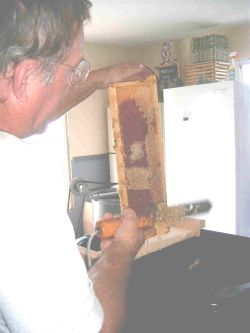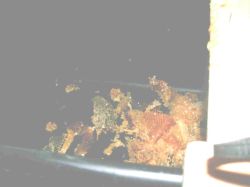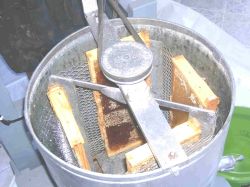|
A little basics about beekeeping to help you understand the pictures.
A 'hive' consists of one or more 'boxes' or 'supers'. These boxes come in standard sizes with varying depths. They are 19-7/8" X 16-1/4" (length X width). The 'deep super' is 9-5/8" deep and generally used just for a brood chamber (where the eggs are laid and baby bees tended). Honey and polled are also kept in the brood chambers surrounding the brood. In southern states, one brood chamber is generally all that is used. In northern states, the general practice is to use 2 brood chambers for the bees to store extra honey to get through the longer winters.
'Medium supers' are used to collect the excess honey the bees produce. Their depth is 6-5/8". Three inches may not sound like a big difference, but can result in 15 pounds of honey.
'Shallow supers' are generally used for comb honey and are only 5-11/16".
Inside a box (super) are 9-10 frames. These frames have a piece of foundation wax for the bees to draw out their honey comb on each side.
During a 'honey flow' when nectar is abundant, the beekeeper needs to check the hives often making sure there is plenty of comb for the honeybees to raise their brood and store the nectar. When most of the honey in a super is capped, the bee keeper can remove for extraction.
What is pictured is the first extraction of honey from our hives.
|

|
Capped honey in a medium frame. Bees store nectar in cells of the honey comb and fan them until water evaporates and it turns to honey. It is then capped for storage.
|

|
Here you see both capped (white) and uncapped honey.
|

|
Paul uses a hot knife to slice the cappings off.
|

|
Close up of uncapping.
|

|
We collect the cappings. These will be cleaned and used for our salves and candles. Other (much larger) beekeepers sell the cleaned cappings to businesses to be made into foundation or used in industry.
|

|
Uncapped frame.
|

|
Close up of uncapped honey.
|

|
Not all of the cappings come off easily with the hot knife. In order to not damage the honey comb cells, we manually scratch the comb to expose the honey.
|

|
This is one type of extractor. As the frames spin around, the honey is flung from the honey comb.
|

|
We were given this extractor by a wonderful beekeeper, George. It hadn't been used in many years as George had gone on to bigger and better extractors. For us, it was the best gift we've been given for our apiary! Paul cleaned it up well, fixed the motor and built a new stand for it.
|

|
It holds four frames. We let it spin for a while, stop it and flip the frames to spin the other side out.
|

|
If you spin too fast, you risk sucking the entire foundation off the frames. Too slow and the honey doesn't all come out. |

|
The very first of our honey! This was a very exciting moment for us!!
|

|
Our first bottled jar, already taste tested, of course!
|
 Honey Harvest 2004
Honey Harvest 2004 




















